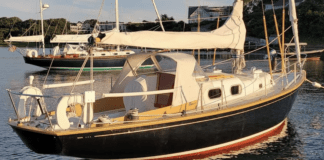One topic often overlooked in any anchor discussion is shank strength. Yet bent anchor shanks are hardly rare, especially among low budget varieties. We accept that sometimes an anchor gets wedged into a crevice where bending is unavoidable, but it seems increasingly more common that anchors are bending during what would be considered normal use.
In the April 2013 issue of Practical Sailor, contributor Jonathan Neeves explores this topic in great detail. In his view, the reasons behind bent shanks are many.
- Industry tests used to rate and certify anchors do not test the shank’s ability to resist bending when subjected to side loads. In fact, these certifications often have little bearing on how a recreational anchor might perform in the real world.
- Manufacturers are using thinner plate steel, or lower grade, lower-tensile steel than is specified in the original design.
- Newer anchors tend to set deeper, remaining immobile when the wind shifts and the load changes direction, causing side-loading on the shank that can cause it to bend. We examine the mechanics behind the ability to deep set in the article, “An Inquiry into Anchor Angles,” in the February 2017 issue of Practical Sailor.
- Anchor makers are using the same design to make anchors of metals with different tensile strength-aluminum, stainless steel, galvanized steel, etc.-which is the same as building below spec.
- Plate stock used to make anchor shanks are sold in specific thicknesses. In order to cut costs, some off-brand anchor makers are using poorly laminated thinner stock to achieve the required shank thickness.
At the heart of our study is a critique of the existing test protocols used to certify these anchors. Neeves points out that these tests were principally designed for anchors used on commercial ships. As he describes, commercial ship anchors have radically different shanks than we find on recreational anchors-shanks that are equally strong no matter what direction they are loaded-and the anchors are used differently. Most ship anchors are, in effect, lunch hooks-not something you try to ride out a storm in.
Accompanying the April 2013 article are photographs of a pretty impressive collection of bent anchors from some of the biggest names in anchor manufacturing. If you have a bent anchor photo you’d like to add to our rogues’ gallery, send it by email to [email protected], and tell us how it happened.
Practical Sailor offers a four volume E-book Anchorsat our online bookstore. The book delves into all the facets of anchoring, comparing the performance of the most popular anchors on the market in various bottoms and discussing the pros and cons of current trends in anchor design. The series also examines other important details such as selecting the right anchor rode, sizing and rigging a storm-ready anchor snubber, selecting the strongest anchor shackles, regalvanizing chain rode, and more.








































